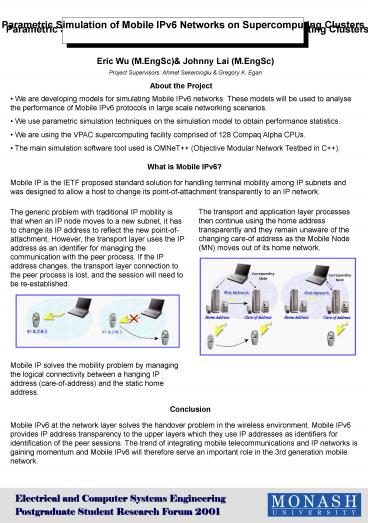Electrical and Computer Systems Engineering PowerPoint PPT Presentation
Title: Electrical and Computer Systems Engineering
1
Parametric Simulation of Mobile IPv6 Networks on
Supercomputing Clusters
Parametric Simulation of Mobile IPv6 Networks on
Supercomputing Clusters
Eric Wu (M.EngSc) Johnny Lai (M.EngSc)
Project Supervisors Ahmet Sekercioglu Gregory
K. Egan
About the Project
- We are developing models for simulating Mobile
IPv6 networks. These models will be used to
analyse the performance of Mobile IPv6 protocols
in large scale networking scenarios. - We use parametric simulation techniques on the
simulation model to obtain performance
statistics. - We are using the VPAC supercomputing facility
comprised of 128 Compaq Alpha CPUs. - The main simulation software tool used is
OMNeT (Objective Modular Network Testbed in
C).
What is Mobile IPv6?
Mobile IP is the IETF proposed standard solution
for handling terminal mobility among IP subnets
and was designed to allow a host to change its
point-of-attachment transparently to an IP
network.
The transport and application layer processes
then continue using the home address
transparently and they remain unaware of the
changing care-of address as the Mobile Node (MN)
moves out of its home network.
The generic problem with traditional IP mobility
is that when an IP node moves to a new subnet, it
has to change its IP address to reflect the new
point-of-attachment. However, the transport layer
uses the IP address as an identifier for managing
the communication with the peer process. If the
IP address changes, the transport layer
connection to the peer process is lost, and the
session will need to be re-established.
Mobile IP solves the mobility problem by managing
the logical connectivity between a hanging IP
address (care-of-address) and the static home
address.
Conclusion
Mobile IPv6 at the network layer solves the
handover problem in the wireless environment.
Mobile IPv6 provides IP address transparency to
the upper layers which they use IP addresses as
identifiers for identification of the peer
sessions. The trend of integrating mobile
telecommunications and IP networks is gaining
momentum and Mobile IPv6 will therefore serve an
important role in the 3rd generation mobile
network.
Electrical and Computer Systems
Engineering Postgraduate Student Research Forum
2001

